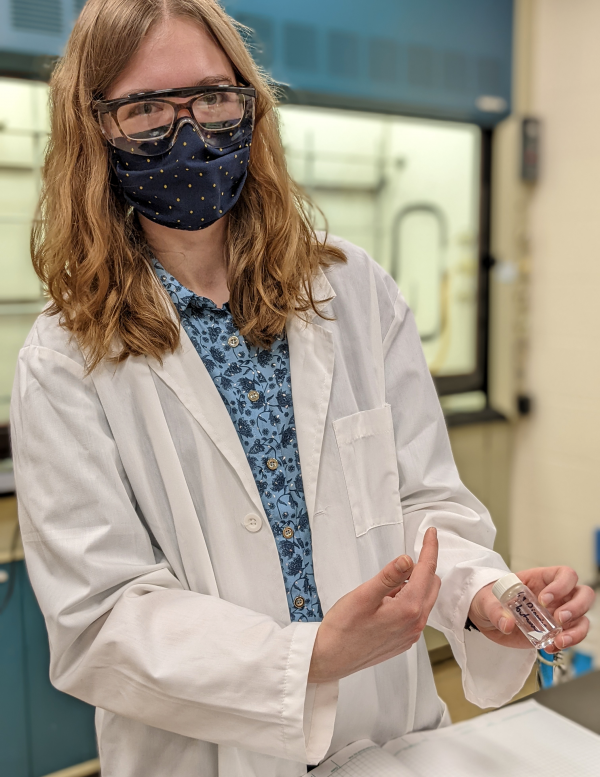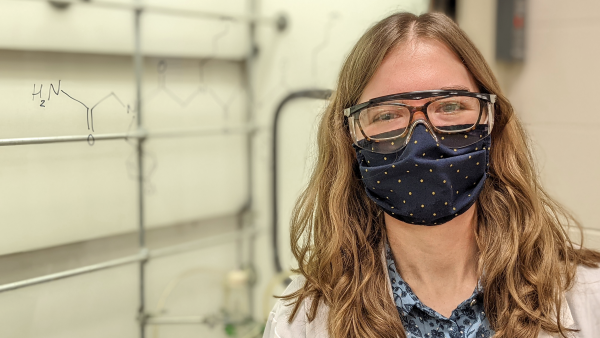
implications for a new approach to antibiotics.
Ola Bartolik ’22 has an intrinsic curiosity about the importance chemistry plays in biology, specifically its role in neurodevelopment and neurological disease. Her high school interests in chemistry led her to apply for Kalamazoo College’s strong chemistry program, where she has been exploring the relationship between chemical structure and antimicrobial activity.
Her research in the lab of Blakely Tresca, assistant professor of chemistry, has possible implications for the development of new antibiotics, which is an urgent need in today’s medical field.
“There is an antibiotic crisis because we’re not finding new antibiotics and there is so much antibiotic resistance,” Bartolik said. “It’s becoming more and more of a problem as time goes by.”
Bartolik works with peptoids, which are man-made compounds similar to peptides, the building blocks of proteins. She is experimenting with adding different halogens to the peptoids to see how that changes the structure and if that plays a role in making the peptoid more anti-microbial.
Two years ago, Tresca saw in Bartolik the first two things he looks for in students—a spark of interest in organic chemistry and an excitement to make molecules in the lab—and invited her to join his lab. There, she discovered that she loves thinking about how research can lead to new questions, solve problems and apply to daily life.
“She has the drive to take ownership of a project and lead it in new directions,” Tresca said. “The project she’s working on right now is one she designed herself and has been leading, which is amazing even for a senior student.”
Bartolik is always prepared, able to work independently and thoughtful about science in both the lab and the classroom, Tresca said.

assistant professor of chemistry, for two years.
“She is almost always the first person to jump up with an answer, which shows how much she’s thinking about what we’re talking about in class,” Tresca said. “I appreciate that she’s always willing to take a guess even if she’s not sure she’s right. They’re not easy questions and they’re things we don’t necessarily know the answer to, so it’s important to be comfortable with being uncomfortable and thinking through the science, which I really see with Ola.”
Tresca has been incredibly supportive in and out of the lab, Bartolik said, helping her apply to scholarships that have made her K experience possible.
“Ola has taught me as much as I’ve taught her, in terms of supporting students, helping them find opportunities and pursue those opportunities even if it’s something they feel like is a stretch,” Tresca said. “Ola is a fantastic person and a fantastic student. It’s been amazing working with her and I’m very excited to see what she does next.”
The support of both faculty and other students at K has been pivotal to Bartolik’s success. Her experiences at an all-girls high school were empowering as well.
Bartolik values the open curriculum at K that has allowed her to choose only courses that interested her, which have ranged from chemistry and biology to literature and philosophy. Even in a sophomore seminar named Poetry as Survival, Bartolik found connections to her science interests as she considered the relationship between coping with difficult life experiences and stress-induced triggers of disease.
“I always had this interest in neuroscience and how the brain works,” she said. “I was interested in the connection between chemistry and neuroscience and how it all works. I like looking at things on a smaller scale, a micro scale. If you change this one thing, what does it do to the whole system?”
For her Senior Integrated Project, Bartolik worked in the lab of Paul Jenkins at the University of Michigan. She investigated an epilepsy associated mutation and how it may impact critical protein-protein interactions necessary for neuronal signaling.
Bartolik will graduate this year with a bachelor’s degree in chemistry with a biochemistry concentration and a psychology minor. She plans to attend graduate school to study neuroscience.
She is interested in studying the effects of environment and mutations on brain development and pathways, and the relationship between problems in those pathways and neurodegenerative diseases.
“Neuroscience programs are really hard to get into, especially when you don’t come from a neuroscience-heavy background with a lot of neuroscience research,” Bartolik said. “The fact that I even have options, I think that tells you how incredible the chemistry department is here and how we’re able to pursue things that don’t have to necessarily relate directly to what we did at K.”

